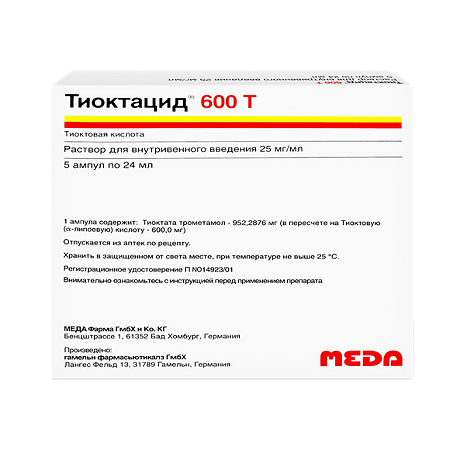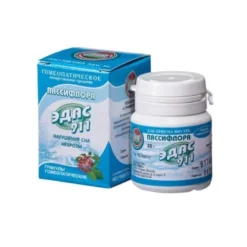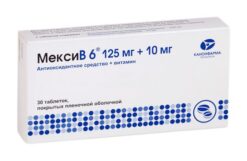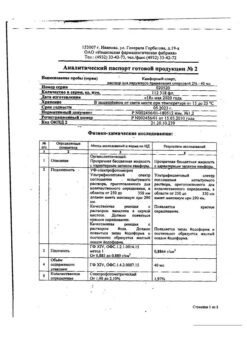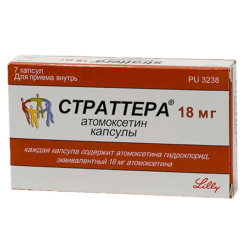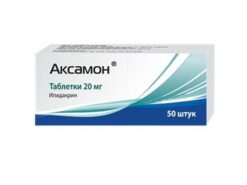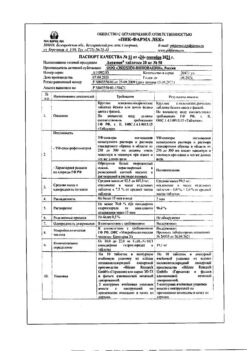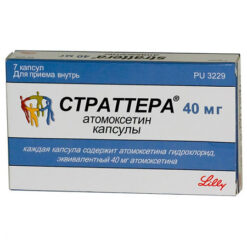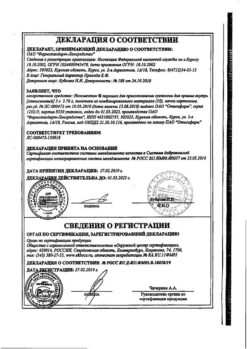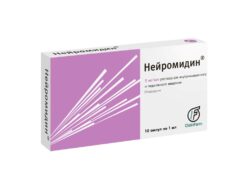Subtotal: €43.70
Thioktacid 600 T, 25 mg/ml 24 ml 5 pcs
€48.67 €40.56
Metabolic agent
ATC code: A05BA
Tiocic acid is found in the human body, where it acts as a coenzyme in the reactions of oxidative phosphorylation of pyruvic acid and alpha-keto acids. Thioctic acid is an endogenous antioxidant, by the biochemical mechanism of action it is similar to the B vitamins.
Tiokoctic acid helps protect the cell from the toxic effects of free radicals generated during metabolic processes, it also neutralizes exogenous toxic compounds into the body.
Thioctic acid increases the concentration of the endogenous antioxidant glutathione, which leads to a decrease in the severity of symptoms of polyneuropathy. The drug has hepatoprotective, hypolipidemic, hypocholesterolemic, hypoglycemic effect; it improves trophic neurons. The result of the synergistic action of thioctic acid and insulin is an increase in glucose utilization.
Pharmacokinetics
The main ways of metabolism are oxidation and conjugation. The volume of distribution is about 450 ml/kg. Thioctic acid and its metabolites are excreted by the kidneys (80-90%). The elimination half-life is 20-50 minutes. Total plasma clearance is 10-15 ml/min.
Indications
Diabetic and alcoholic polyneuropathy.
Pharmacological effect
Thioctic (a-lipoic) acid is found in the human body, where it functions as a coenzyme in the oxidative phosphorylation reactions of pyruvic acid and alpha-keto acids. Thioctic acid is an endogenous antioxidant; according to its biochemical mechanism of action, it is close to B vitamins.
Thioctic acid helps protect cells from the toxic effects of free radicals arising in metabolic processes; it also neutralizes exogenous toxic compounds that have entered the body. Thioctic acid increases the concentration of the endogenous antioxidant glutathione, which leads to a decrease in the severity of symptoms of polyneuropathy. The drug has hepatoprotective, hypolipidemic, hypocholesterolemic, hypoglycemic effects; improves neuronal trophism. The result of the synergistic effect of thioctic acid and insulin is an increase in glucose utilization.
The main metabolic pathways are oxidation and conjugation. Volume of distribution is about 450 ml/kg. Thioctic acid and its metabolites are excreted by the kidneys (80-90%). The half-life is 20-50 minutes. Total plasma clearance – 10-15 ml/min.
Special instructions
Thioctic acid infusion solution is incompatible with dextrose solution, Ringer’s solution and with solutions that react with disulfide and SH groups, ethanol. Alcohol consumption is a risk factor for the development of polyneuropathy and can reduce the effectiveness of Thioctacid® 600T, therefore patients should refrain from drinking alcoholic beverages both during treatment with the drug and during periods outside of treatment.
Treatment of diabetic polyneuropathy should be carried out while maintaining optimal blood glucose concentrations.
Active ingredient
Thioctic acid
Composition
1 ampoule of solution contains:
Active substance: trometamol thioctate – 952.2876, in terms of thioctic (alipoic) acid – 600 mg.
Excipients: trometamol, water for injection
Contraindications
Hypersensitivity to thioctic acid or other components of the drug. Pregnancy, breastfeeding period (there is no sufficient experience in using the drug).
There are no clinical data on the use of Thioctacid® 600 T in children and adolescents; therefore, the drug should not be prescribed to children and adolescents.
Side Effects
The incidence of side effects is determined as follows: Very common: > 1/10;
Often: 1/100; Uncommon: 1/1000; Rare: 1/10000;
Very rare: <1/10000.
Allergic reactions:
Very rarely – skin rash, urticaria, itching, eczema, redness of the skin, systemic allergic reactions up to anaphylactic shock.
From the nervous system and sensory organs: Very rarely – convulsions, diplopia.
From the blood and cardiovascular system:
Very rarely – purpura, pinpoint hemorrhages and bleeding tendency (due to impaired platelet function), thrombocytopathy, thrombophlebitis.
General:
Often – with rapid intravenous administration, an increase in intracranial pressure and difficulty breathing may be observed, which resolve on their own.
Uncommon: disturbance of taste (metallic taste). Rarely, allergic reactions may occur at the infusion site. Rarely – nausea and vomiting.
Very rarely – due to improved glucose utilization, blood glucose levels may decrease and symptoms of hypoglycemia may appear (confusion, increased sweating, headache, visual disturbances).
Interaction
With the simultaneous administration of thioctic acid and cisplatin, a decrease in the effectiveness of cisplatin is observed. With simultaneous use of thioctic acid and insulin or oral hypoglycemic drugs, their effect may be enhanced, therefore regular monitoring of blood glucose levels is recommended, especially at the beginning of therapy with thioctic acid. In some cases, it is permissible to reduce the dose of hypoglycemic drugs to avoid the development of symptoms of hypoglycemia.
Ethanol and its metabolites weaken the effect of thioctic acid.
Overdose
There have been no cases of overdose of thioctic acid in the form of a solution for intravenous administration.
In case of overdose – symptomatic treatment, if necessary – anticonvulsant therapy, measures to maintain the functions of vital organs.
Storage conditions
Store in a place protected from light at a temperature not exceeding 25° C.
Keep out of the reach of children!
Shelf life
4 years.
Do not use after expiration date.
Manufacturer
Siegfried Hameln GmbH, Germany
| Shelf life | 4 years. Do not use after the expiration date. |
|---|---|
| Conditions of storage | Store in a light-protected place at a temperature not exceeding 25 ° C. Keep out of reach of children! |
| Manufacturer | Siegfried Hameln GmbH, Germany |
| Medication form | solution |
| Brand | Siegfried Hameln GmbH |
Related products
Buy Thioktacid 600 T, 25 mg/ml 24 ml 5 pcs with delivery to USA, UK, Europe and over 120 other countries.


